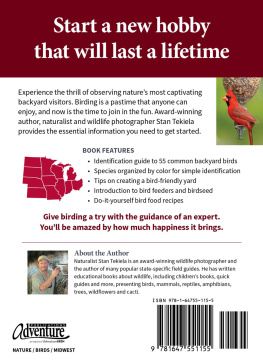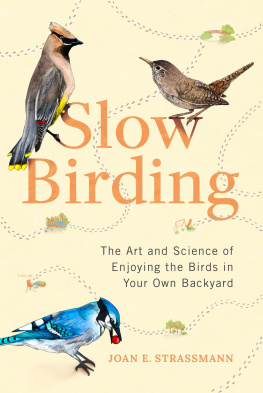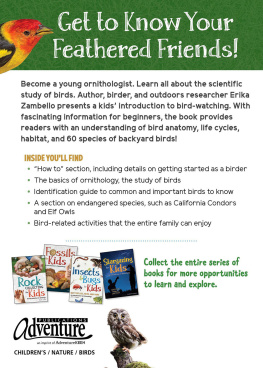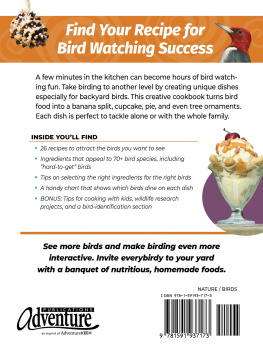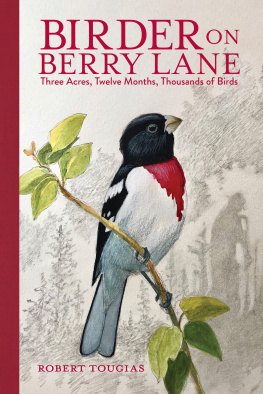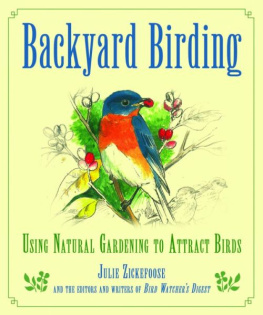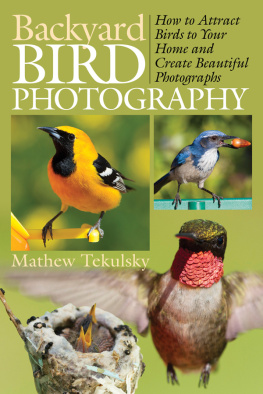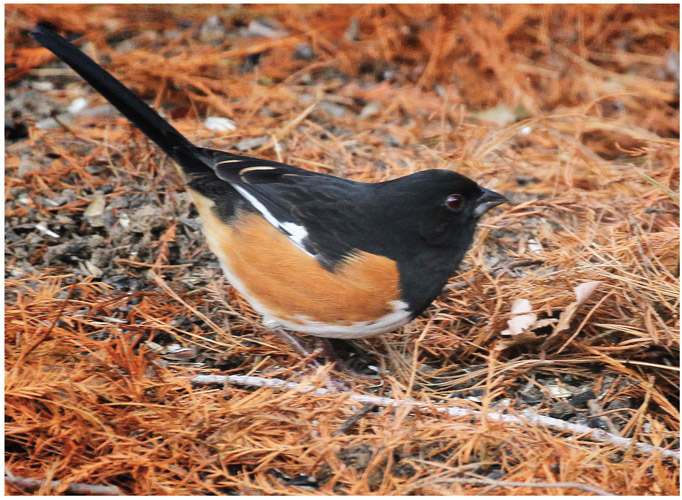T wo groups of folks triggered the concept for a book about how birds behave: those who asked how and those who answered.
As a newspaper columnist, Ive written the prerequisite 550 biweekly words about birds for more than a dozen years. The columns often prompt readers questionsthoughtful, curious, and downright inspiring. Then in a cooperative venture with the local public library, we offered birding classes that ultimately evolved into monthly 2-hour sessions, ongoing now for over ten years, still available free to the public. Hundreds of folks have scanned the columns, attended the classes, scoured my website, and followed my social media posts about birds. And theyve asked questions. Questions in class, questions via email, questions on social media. Good questions. So to them, I extend my gratitude for showing interest and directing my attention to the kinds of things you want to know. Thank you for your inquisitive minds.
Of course, you made me work. Good questions deserve good answers, and you sent me on the search. I owe a deep debt of gratitude to the folks and their resources that helped provide the answers. Among the invaluable online resources, the premier site is Birds of North America Online, this nations definitive reference for all things bird. Thanks to Indiana Audubon Society for providing subscription access to this end-all/be-all reference. AllAboutBirds.org, Cornell Universitys Lab of Ornithology website, catalogs the basics about identification, habitat, and breeding. Its always the best place to begin a general search. eBird.org has become the source for pinpointing birds locations during any month of the year, clarifying beyond published maps the real-time summer, winter, and migration ranges of any bird in the world. BirdCast.info, a readily accessible seasonal radar site, predicts three-day migration patterns, a dandy aid for planning watch days.
Years-long subscriptions and memberships have brought commercial magazines and professional journals to my desk, every issue replete with details about how birds behave. Favorites include Birdwatchers Digest, Bird Watching (formerly Birders World), Living Bird (Cornell Lab of Ornithology), Birding (American Birding Association), Bird Conservation (American Bird Conservation), and the related INPS Journal (Indiana Native Plant Society), all of which have educated me for the past twenty-five years. Regular columnists in these publications pepper their works with juicy tidbits gleaned from who-knows-where. Folks like (in alphabetical order) Paul Baicich, David Bird, Kevin Cook, Julie Craves, Lara Erickson, Don Freiday, Eldon Greij, George H. Harrison, Dawn Hewitt, Alvaro Jaramillo, Kevin Karlson, Brian Sullivan, Connie Toops, and Julie Zickefoose become my go-to writers in every issue. Ive met only a couple of these experts, but I feel that I know them all and hold them all in high regard for teaching me.
Other favorite writers, whose nearly 200 books line my shelves and who have given me hours and hours of pleasure and an all-but-free education, providing more answers than I can credit, include Jennifer Ackerman, for sharing the research in The Genius of Birds; Miyoko Chu, especially for her Songbird Journey: Four Seasons in the Lives of Migratory Birds; Pete Dunn, for his witty commentary in every book hes done but especially Essential Field Guide Companion; Bernd Heinrich, for writing reams about birds in laymans language; Kenn Kaufman, not only for his field guides but also for his regular outpouring of advice and information in numerous columns and articles; Donald Kroodsma, for his remarkable research and writing about birdsong, especially The Singing Life of Birds; Roger J. Lederer, for explaining how birds adapt their behavior, especially in Beaks, Bones and Bird Songs; John M. Marzluff, for his contemporary look at human impact on birds, especially in Welcome to Subirdia; Roger Tory Peterson, not just for his early ground-breaking approach to identifying birds but also for his clear, poignant writing and lifetime commitment to birds; David Sibley, for his thorough field guides in both print and on my now-favorite birding app as well as his concise writings in multiple publications; Alexander Skutch, for his unusual topics, especially Birds Asleep; Doug Tallamy, for introducing me to the research about the importance of native plants to birds survival, inspiring me to further restore our yard to native, thus providing the springboard for me to write Plant Natives to Attract Birds to Your Yard; and Scott Weidensaul, for his prolific writings, especially those triggering my ongoing education about migration.
In addition, organizations regular monthly, bimonthy, or quarterly publications and websites have always been standard go-to references when drilling down for details, including especially those for the National Audubon Society, the National Wildlife Federation, and The Nature Conservancy. Thanks to them for the services they provide. Memberships help them continue their services.
A special thanks to Judith Schnell, Stackpole Books editor, for guiding the direction of this book and seeing it through to production.
And finally, a heartfelt hug to Charles, my lifelong companion and husband of more than fifty years, for his tolerating my time away from him to teach, write, research, and answer all the thoughtful, curious, and inspiring questions. His photographs have added an immeasurable quality to this work. Thank you, babe.
May you, my readers, enjoy the fruits of the labors of all these incredibly knowledgeable folks as their efforts have now filtered through my own, enabling me to share my meager yearlong role in observing and explaining how birds behave.
A male Northern Cardinal perches on a snow-covered hemlock bough, finding protection from the wind.
The sound of birds stops the noise in my mind.
Carly Elisabeth Simon (1945)
January 1
Welcoming the New Year
After last nights lovely full moon, the sun crawled up from behind the trees on a new year, clear, crisp, windy, a frigid 3 degrees. My eyes opened to see my first birds of the year: a Northern Cardinal foraging on the ground next to a White-throated Sparrow sipping at the heated bubble rock. What a perfect combination to represent the season. Our year-round bright cheer-me-upper and a regular winter visitor, bright yellow lores setting off its white-striped cap and white bib.
Around 7 a.m. each day, just at winters dawn, the birdsespecially Northern Cardinals, Tufted Titmice, and Blue Jaysexpect their daily handout of a cup of split peanuts. So out the door I went in my PJs and hooded parka to add sunflower seed to partially emptied feeders and pour the peanuts into the ground-level platform feeder. As I cracked open the door, a half dozen Mourning Doves whirred to life, their flight a frantic reaction to my intrusion, costing them wasted energy on such a frigid morning. I hated that I disturbed them.
A male Eastern Towhee, a typical ground feeder, forages for seed, both native and feeder-spilled.
In the near distance, I caught the weak Whee? call of the Eastern Towhee. A ribbon of birdslikely a mix dominated by Red-winged Blackbirds but surely including among the hundreds at least a few European Starlings, Common Grackles, and Brown-headed Cowbirdswove its way across the sky from south-southwest to north-northeast, scattered in a broad band that undulated overhead the entire 3 or 4 quick minutes I spent outside. Several families of American Crows angled west/southwest to east/northeast at an altitude below the ribbon of other black-colored birds. All had probably departed overnight roosts near the Wabash River and were heading toward harvested agricultural grain fields, their feeding grounds for the day. Taking due note of their appearances, I finished the quick work of dispensing seed and darted back inside.


